State flag
The NSW State flag has been in use since 1876. It includes the Union Jack and the NSW badge. The flag is flown on special occasions and at half-mast as a sign of mourning.

Protocol
A flag is an emblem which stands for its people, history and ideals. NSW has its own distinctive flag. As the premier symbol of NSW since 1876, the NSW flag represents all the people of the state.
The NSW Government supports the flying of both the NSW and national flags, and encourages everyone to become familiar with the protocols for the correct use of these flags.
History
By the Colonial Naval Defence Act of 1865 it became lawful for any colony, subject to certain conditions, to provide and maintain its own vessels of war, and these were authorised to wear the Blue Ensign with the seal or badge of the colony in the fly.
The earliest badge of the Colony of New South Wales was the Red Cross of St George on a silver field. This was authorised in an Order-in-Council of the British Government, dated 7 August 1869.
On 15 February 1876, a new badge was proclaimed in the New South Wales Government Gazette.
The notice read:
"His Excellency the Governor has been pleased, with the advice of the Executive Council, to direct that, for the future, the badge of the Colony to be emblazoned in the centre of the Union Jack used by the Governor when afloat, and to be inserted in the Blue Ensign by vessels in the employment of the Colonial Government, shall be as hereinafter described:
Argent, on a cross gules a lion passant guardant or, between four stars of eight points also or” (Silver with, on a red cross, a golden lion walking forwards while looking at the viewer, between four gold stars each with eight points).
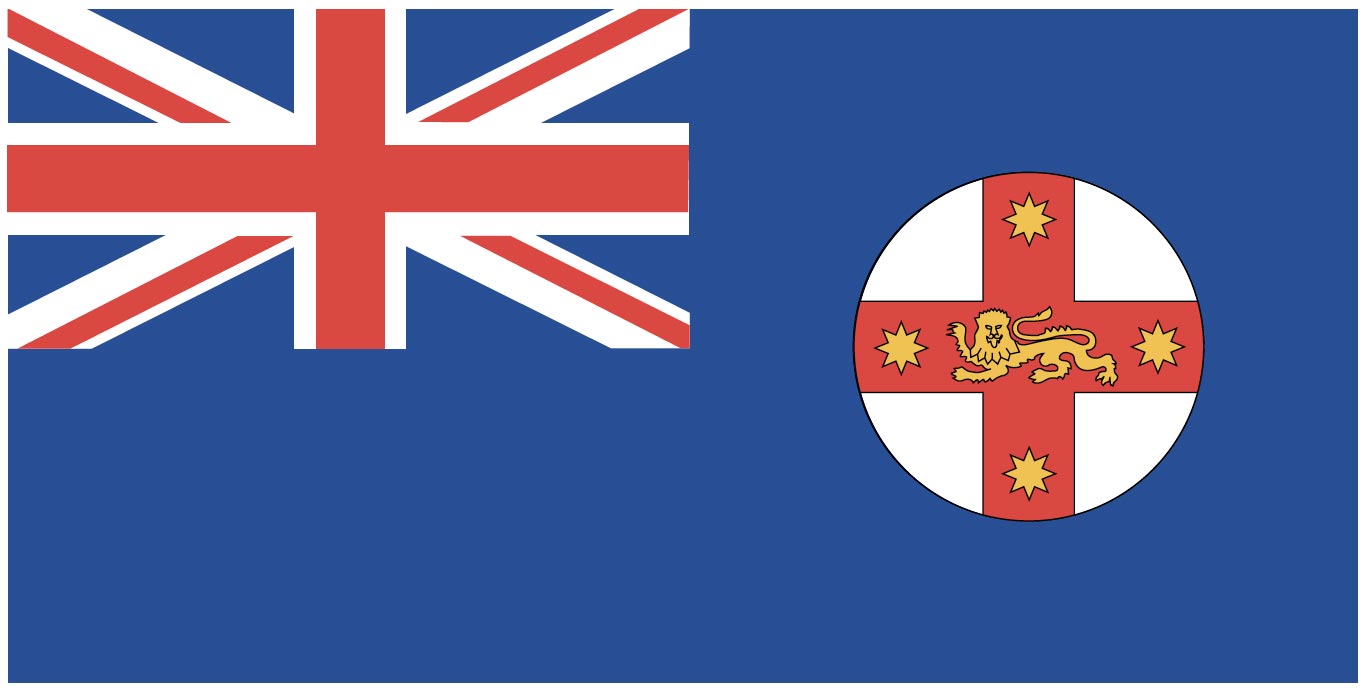
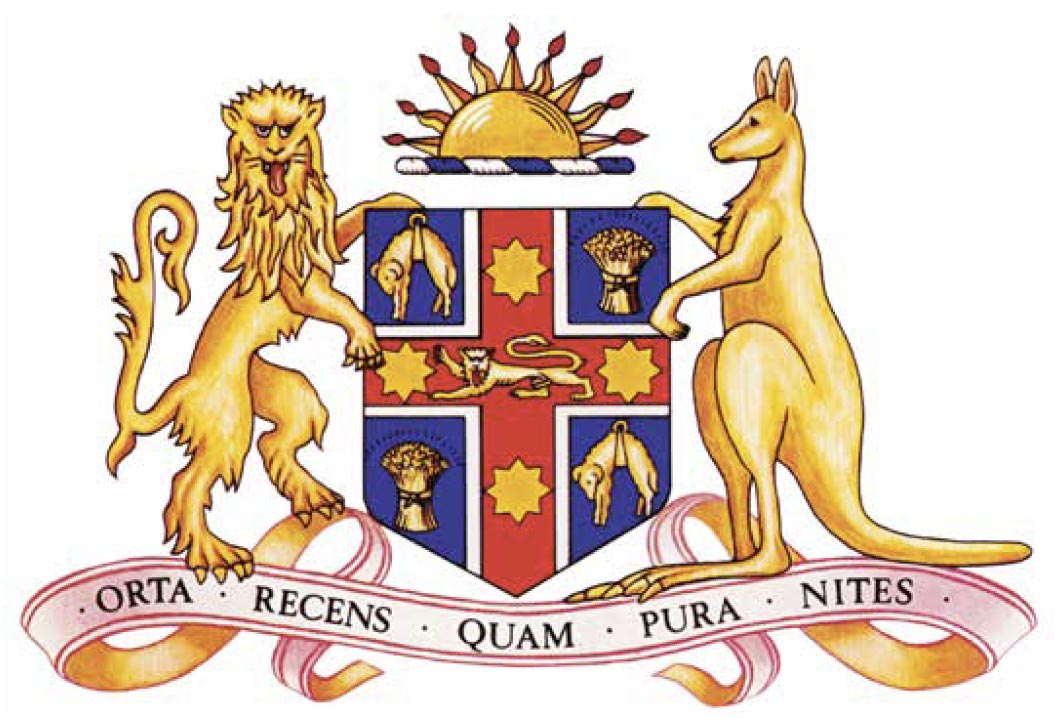
King Edward VII approved the Coat of Arms in October 1906 with the words:
“Know ye therefore that We of Our Princely Grace and Special Favour have granted and assigned and by these Presents do grant and assign the following Armorial Ensigns and Supporters for the said State of New South Wales that is to say for Arms Azure a Cross Argent voided Gules charged in the centre chief point with a Lion passant guardant, and on each member with a Mullet of eight points Or between in the first and fourth quarters a Fleece of the last banded of the second and in the second and third quarters a Garb also Or: And for the ‘Crest on a Wreath of the Colours a Rising Sun each Ray tagged with a Flame of fire proper: And for the Supporters On the dexter side A Lion rampant guardant: And on the sinister side ‘A Kangaroo both Or’, together with this Motto, ‘Orta Recens Quam Pura Nites’.”
The New South Wales state crest was gazetted on 18 February 1876.
The central red cross, in a larger silver cross, is the Red Cross of St George, the old badge of the colony. It is also the Navy flag badge and so recognises the work of such naval officers as Captain Cook and governors Philip, Hunter, King and Bligh.
The four stars on the cross represent the Southern Cross – from earliest time a mariner’s guide in the south and referred to so often in our poetry and literature as a national symbol.
The lion in the centre is the English Lion derived from the British Arms.
The first and fourth quarterings are the Golden Fleece, a reference to our great achievement in the wool industry.
The second and third quarterings are the Wheat Sheaf, representing our second and great primary industry.
The crest, the Rising Sun, continues the use of our earliest colonial crest, representative of a newly rising country. The livery colours of the Arms, blue and white, mirror the state’s sporting colours.
The right-hand supporter, the lion, is a further recognition of the British origin of our first European settlers and the continuing connection between New South Wales and Great Britain.
For the left-hand supporter, the use of the kangaroo is self explanatory. It is our most distinctive animal, restricted almost entirely to Australia and adopted so often as an emblem of Australia.
The motto of New South Wales “Orta recens quam pura nites” may be translated “Newly risen how brightly you shine” and, like the rising sun in the crest, is representative of our continuing progress and development.
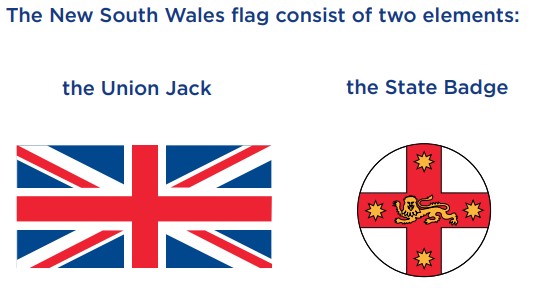
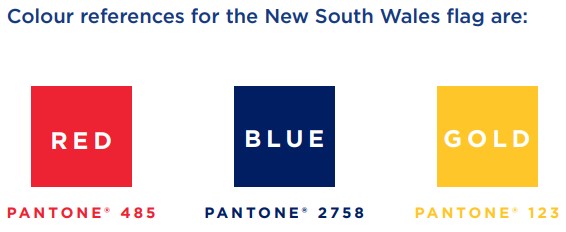
Using the flag
National flags of sovereign nations should be flown on separate staffs and at the same height. If possible, all flags should be the same size.
The Australian national flag should be hoisted first and lowered last.
The flag should always be flown or displayed in a dignified way and flags should never be used for the unveiling of a monument or plaque, or used as a table or a seat cover, or let fall onto or lie upon the ground. If a purely decorative effect is desired without the involvement of precedents, it is better to confirm the display to flags of lesser status, for example, house flags, or pennants of coloured bunting.
Flags should never be flown at night unless properly illuminated.
You should avoid flying more than 1 flag from the same halyard.
A ruined or worn flag should not be flown or displayed. When a flag is no longer suitable for use it should be destroyed privately.
There are special rules for flying the United Nations flag. All members of the United Nations have agreed that on United Nations Day, 24 October, if only 1 position is available, the United Nations flag should be flown.
Ceremonial raising or storage
Ideally, and when possible, the flag should be raised at 8am and lowered at sunset.
Flags should be dried before storing and repaired or replaced when torn or faded.
Folding the flag
Follow the diagrams for the proper folding of your flag.
1. Start in this position.
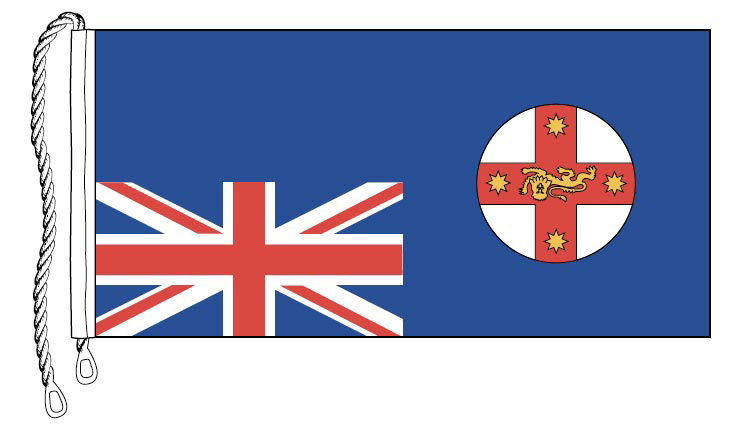
2. Fold it lengthwise once and then once again.
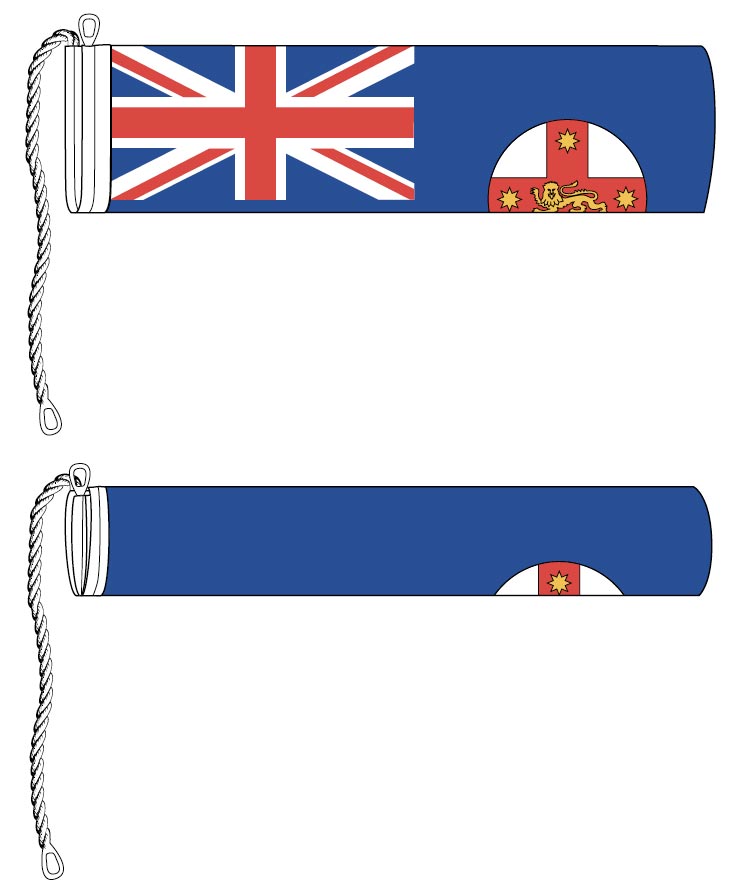
3. Bring the two ends together.
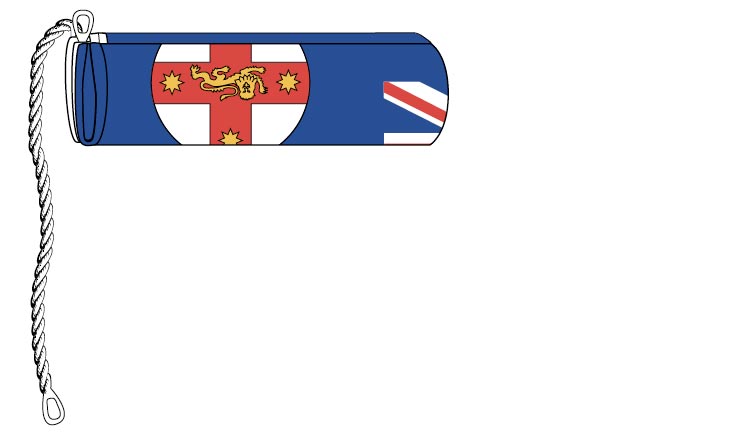
4. Now concertina by folding backwards and forwards, until it is neatly bundled.
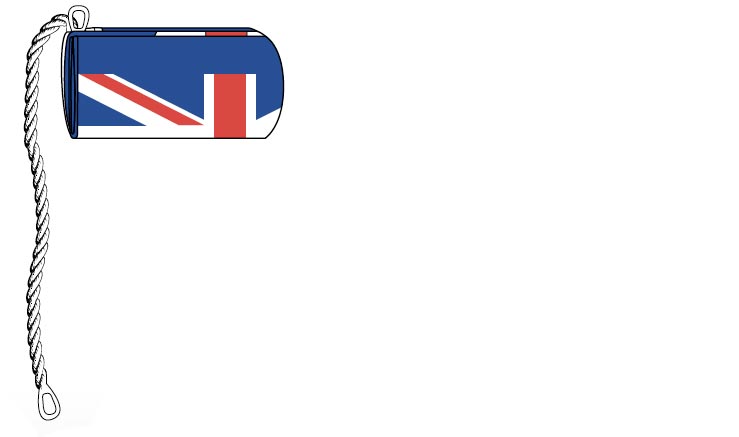
5. It is kept bundled by winding the rope under itself.

As the main symbol of NSW, the flag represents all the people of the state. The NSW Government encourages the use of the flag by private individuals, businesses and organisations. The NSW flag should be flown or displayed in a dignified way and treated with respect.
1 January - Anniversary of the establishment of the Commonwealth of Australia
26 January - Australia Day
13 February - Apology to members of the Stolen Generation
March, second Monday - Commonwealth Day
25 April - Anzac Day (flags flown at half-mast until noon then full-mast for the remainder of the day)
26 May - National Sorry Day (The Australian Aboriginal Flag and the Torres Strait Islander Flag should be flown on additional flagpoles, where available, next to or near the Australian National Flag)
27 May – 3 June - National Reconciliation Week (The Australian Aboriginal Flag and the Torres Strait Islander Flag should be flown on additional flagpoles, where available, next to or near the Australian National Flag)
June, second Monday - The King’s Birthday
First full week of July - NAIDOC Week
3 September - Australian National Flag Day
17 September - Citizenship Day
29 September - NSW Police Remembrance Day
12 October - NSW Terrorism and Homicide Victims Remembrance Day
24 October - United Nations Day
11 November - Remembrance Day (flags are flown at full-mast from 8am to 10:30am. Lower to half-mast until 11:02am and then raise to full-mast for the remainder of the day)
Note: Flags are also flown on special occasions and at half-mast for State Funerals, State Memorials and funerals of Heads of State of other countries.
When a flag becomes old or ruined and is no longer in a good condition, it should be destroyed privately in a respectful way.
Are you unsure of the flag protocols around a particular day or look to seek advice on what days to fly the NSW flag?
All NSW flag marshals now have the opportunity to register for the NSW Flag Network.
By joining the network, you will be the first to be notified via email with the latest flag protocol for special occasions such as Anzac Day, or on occasions when flags should be half-mast.
To subscribe to the NSW Flag Network or further information about flying flags or flag protocols, email Protocol NSW at the Premier's Department.
Flying the flag
You should follow these general procedures for flying the NSW state flag alone or in combination with the Australian national flag and other flags or pennants.
Flags are flown at the half-mast position as a sign of mourning.
The flag is brought to the half-mast position by first raising it to the masthead and immediately lowering it slowly to the half-mast position. The flag should be raised again to the top before being lowered for the day.
The position of the flag when flying at half-mast will depend on the size of the flag and the length of the flagpole.
It must be lowered to a position obviously half-mast so it does not appear to have accidentally fallen away from the masthead.
Half-masting would normally be when the top of the flag is one-third of the distance down from the top.
For the half-masting of flags on Anzac Day and Remembrance Day, refer to special occasions on which flags should be flown.
A flag should never be flown at half-mast at night, whether or not the flag is illuminated.
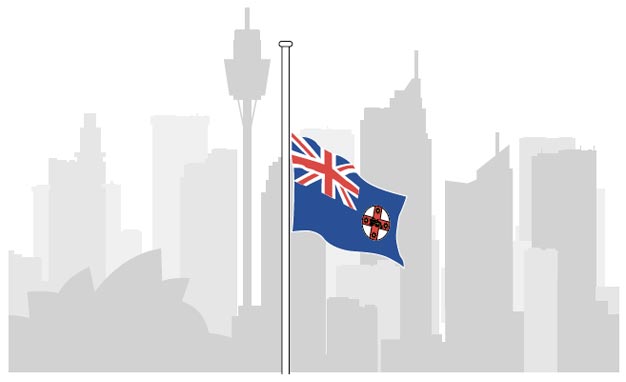
Colour references for the NSW flag are:
Red: Pantone 485
Blue: Pantone 2758
Gold: Pantone 123
Flying flags on or in front of:
1. A building with one flagpole with cross arms
(i) The Australian national flag is flown from the halyard on the left of the observer facing the building.
The NSW state flag is flown from the halyard on the right of the observer facing the building.
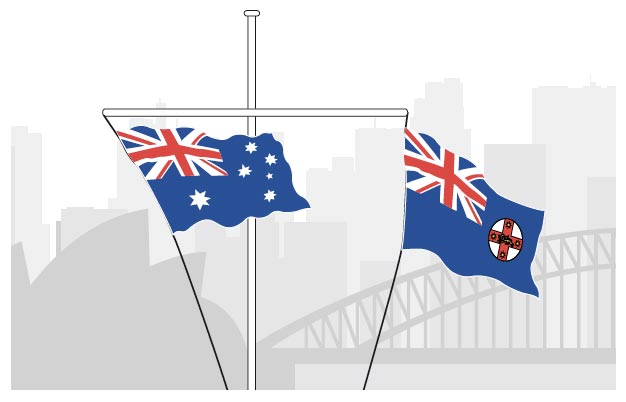
or
(ii) The Australian national flag is flown from the masthead.
The NSW state flag is flown from the halyard on the left of the observer facing the building.
A house flag or club pennant is flown from the halyard on the right of the observer.
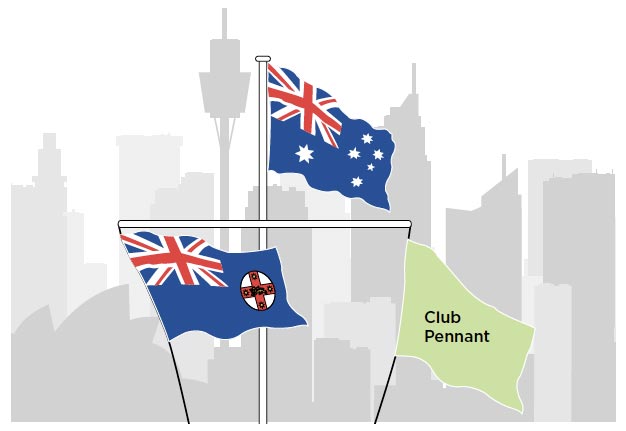
2. A building with 2 flagpoles of equal height
The Australian national flag is flown on the flagpole on the left of the observer facing the building.
The NSW state flag is flown on the flagpole on the observer’s right.
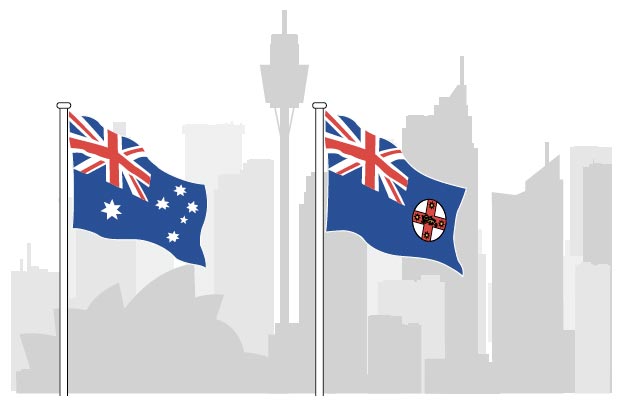
3. A building with 3 flagpoles of equal height
When flying another national flag:
(i) The Australian national flag is flown on the flagpole on the left of the observer facing the building.
Other national flags are flown on the centre flagpole.
The NSW state flag is flown on the flagpole to the observer’s right.
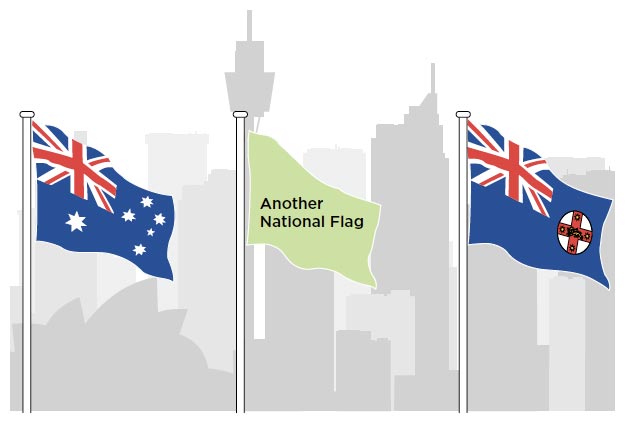
When flying a house flag or club pennant
(ii) The Australian national flag is flown on the flagpole on the left of the observer facing the building.
The NSW state flag is flown on the centre flagpole.
A house flag or club pennant is flown on the flagpole on the observer’s right.
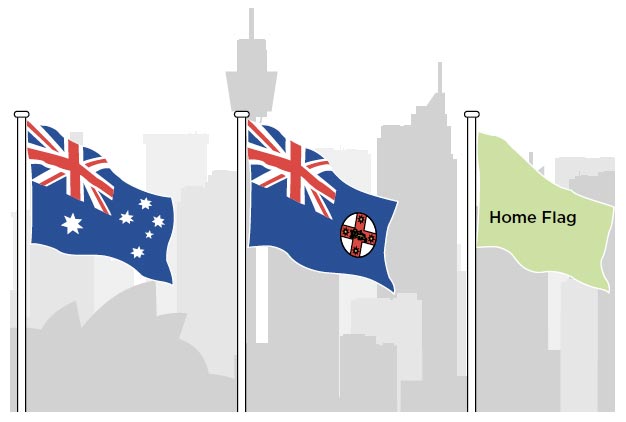
4. A building with 3 flagpoles, when the centre pole is higher than the other 2
The Australian national flag should be flown from the centre pole.
The NSW state flag is flown on the flagpole on the left of the observer facing the building.
A house flag or club pennant is flown on the flagpole on the observer’s right.
If only the Australian national flag and the NSW state flag are available, they should be flown on the 2 outside poles (omitting the higher centre pole).
If 2 national flags are to be flown, they should be flown on the 2 outside poles (omitting the higher centre pole). No national flag should be flown higher than another.
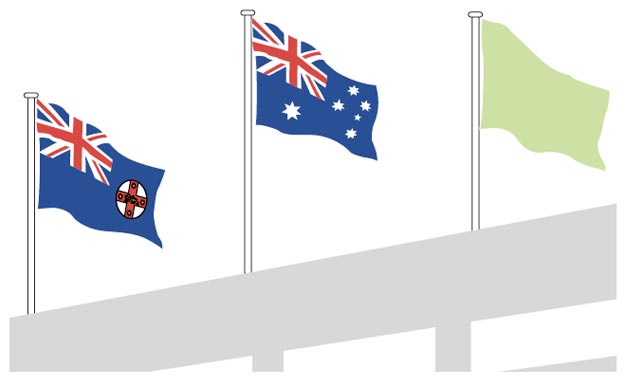
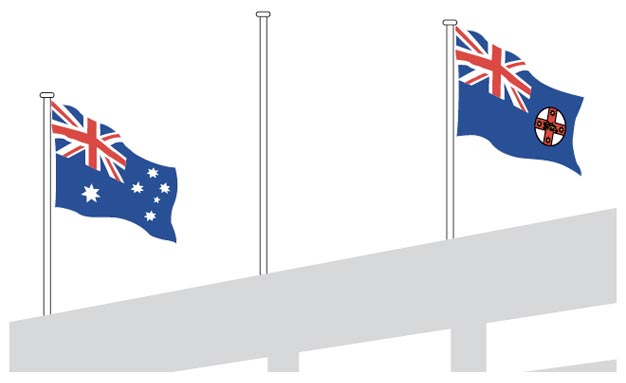
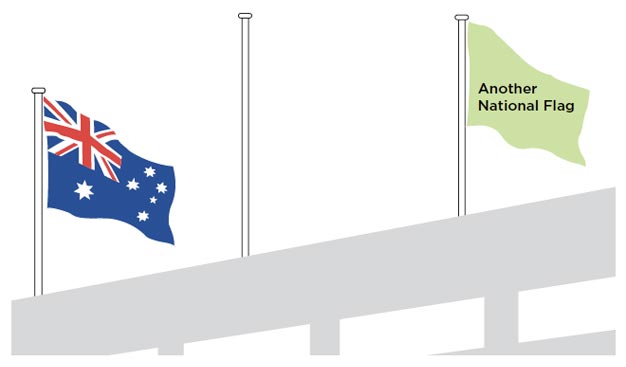
The top left quarter of the flag is to be placed at the top on the observer’s left.

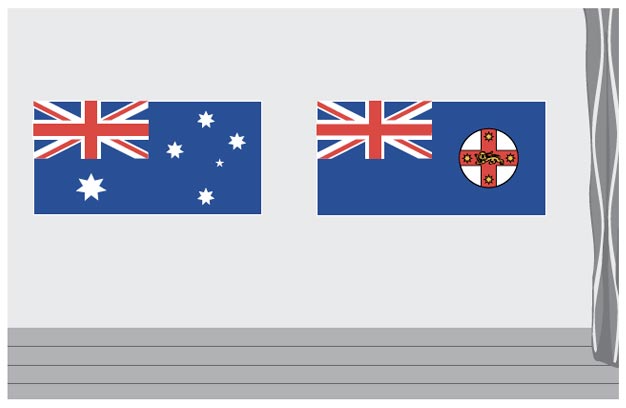
The Australian national flag should be on the left of the observer facing the flags. The staff should be in front of the staff of the other flag.
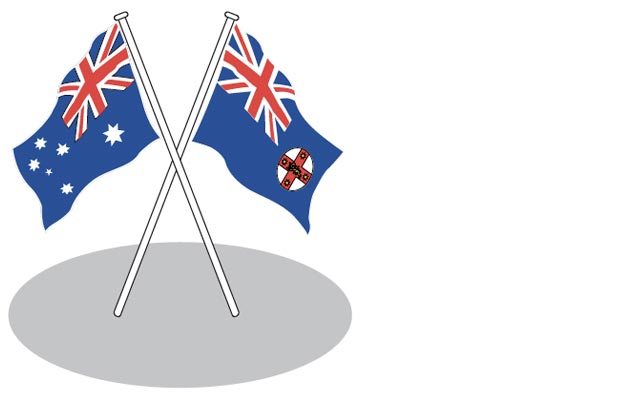
The Australian national flag should be carried at each end of the line.
The NSW state flag is flown to the right of the Australian national flag (as seen by a viewer facing the flag bearers).
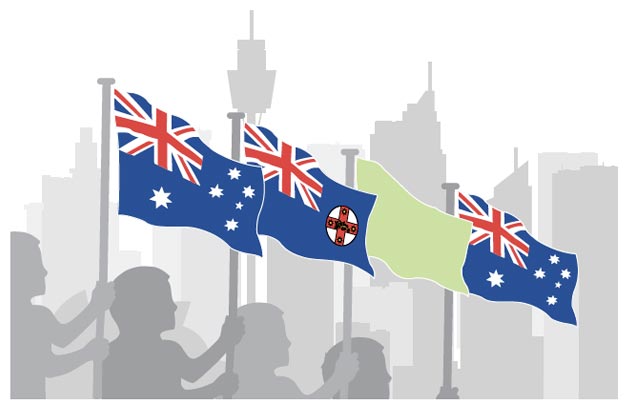
The Australian national flag is carried on the right facing the direction of movement.
The NSW state flag is carried on the left of the national flag.
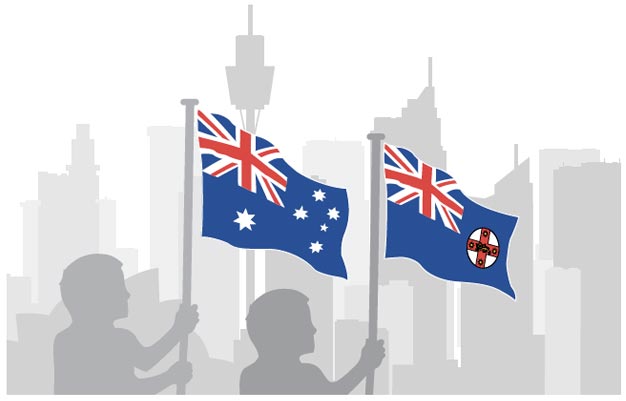
In a semi-circle of flags, the Australian national flag should be in the centre, with the NSW state flag positioned on the right.
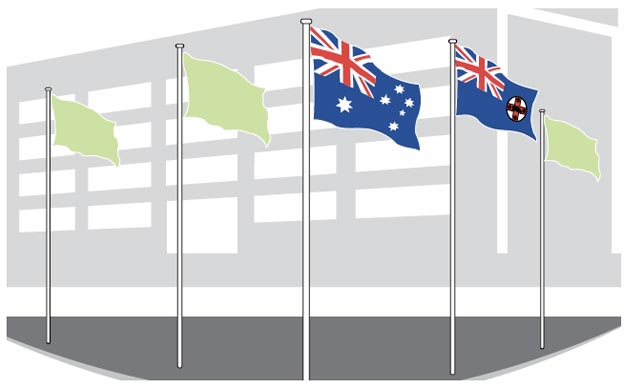
In an enclosed circle of flags, the Australian national flag should be flown on the flagpole immediately opposite the main entrance to the building or arena, with the NSW state flag positioned on the right.
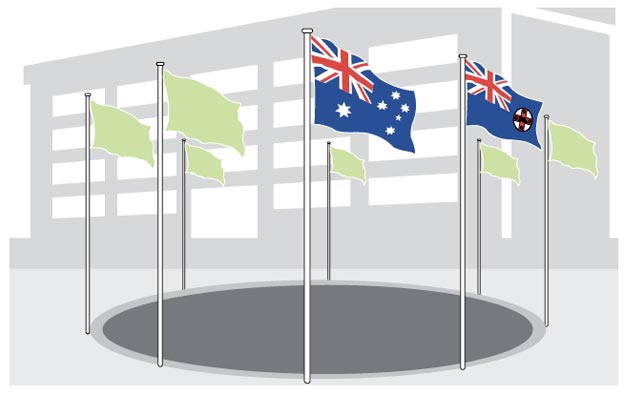
The Flag and Emblems of NSW booklet
This booklet outlines the rules for the flying of flags. It also contains information about other emblems of our state, such as the waratah, the platypus and the kookaburra.